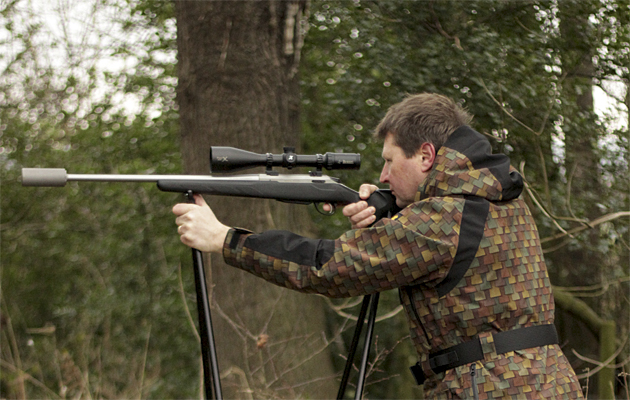Having the best balance when stalking is essential, but which is most useful in the Field? Bipod, tripod or quadpod? Dominic Griffith guides us through the options.
Bipod or tripod, or perhaps the quadpod? Dominic Griffith debates the merits and drawbacks of the various shooting aids on the market. Whether your tastes run to the pint-sized muntjac, the smallest deer gives sporting stalking, or red deer in the glen, every shot needs to be well-balanced. Is the bipod or tripod fit for service?
The days of iron sights and a “sporting shot” are long behind us. Our aim today, having completed a successful approach, is to ensure as quick and humane a shot as possible. To that end, few would choose to go stalking without the appropriate shooting aids – and those aids vary according to the type of shooting, the conditions and the quarry.
BIPOD OR TRIPOD? WHICH OFFERS BEST BALANCE?
The bipod is now almost universally carried as a standard attachment, whether stalking red in the Highlands, roe in the forests or fallow in the fields. Its benefit when taking a prone shot far outweighs its handicap when not in use. Yes, it slightly imbalances a rifle, pushing the point of balance forward – as does a moderator – and, yes, it can get in the way when opting for a standing shot on sticks. But, given a prone shot, it locks the rifle absolutely solidly on the target leaving little room for error. Bipods come in a variety of extending heights and the best are pivoted to allow for uneven ground. The Harris L (9in to 13in) would suit most conditions but the 25 version (12in to 25in) can also be used for sitting shots. The sitting shot is a generally underused position, locking almost as solid as a prone shot but giving important height over grasses and heather. It is particularly useful when taking steep downhill shots as well as saving many a sore back caused by the discomfort of lying prone. My only issue with bipods is when crawling through deep heather in the Highlands as the folded legs can get caught in the twiggy mass and you end up having to raise the rifle too high in order to drop the legs; frequently this is too much movement for a flighty hind.

Harris L Bipod (9-13) or Primos Trigger Stick (right): a choice between ease and noise.
Although we should all learn to be capable in an emergency of shooting completely freehand, at least up to 50 metres, when woodland stalking most of us nowadays use a stick, or a bipod or tripod. A single stick improves accuracy by a margin, a double stick doubles that margin, and a triple stick, provided that you practise with it so that you can set it up smoothly and effortlessly, doubles that margin once again. A triple with a revolving ‘“V” provides perhaps the best support for a standing shot. The Primos Trigger Tripod Stick is height adjustable at the press of a button but, as with all multi-leg sticks, there is an unacceptable compromise between ease and speed of handling on the one hand, and the potential for noise (most are made of aluminium) and undue arm movement that alerts the deer to your presence on the other hand. So, the inverse is true regarding manageability when it comes to the bipod or tripod: the triple can trip you up, the double is less demanding and the single stick is simple.
But what of the brand-new Hammond Quadpod? In essence it is a compact, adjustable stalking stick that can be used effortlessly and quietly as a single binocular/rifle rest; opened to a double stick; or opened further to a secure rifle rest supported at two points (under the fore-end and behind the pistol grip). Comprising four bonded legs, it may look like products that have been around for some years but it is re-engineered to a fantastic standard of build quality. Using internal spring-ball catches for height adjustment means that there are no external plastic hasps to rattle, break or catch. There is no need for a strap to stop the legs falling apart, as the whole unit is designed to open only as far as necessary. Thus the pod opens naturally and effortlessly to any of the positions, with no need for flailing arms and the clash of metal on metal. It is also unique in that it offers a small amount of lateral movement due to the flat, rubberised surface of the forward rest. Developed in Denmark and weighing just under 1.2kg, it is new to the UK market and, in my view, the most versatile and practical product of its type that I have ever seen.
Using many of its competitors is like trying to erect scaffolding at the most sensitive moment of the stalk, but the simple Hammond Quadpod converts effortlessly and noiselessly as and when needed.
STICKS AND PODS
If you want a bipod or tripod, or a quadpod see where to buy below.
The Hammond Quadpod £157 is available from the sole UK distributor:
Hammond Sporting
Plumtree House, Esh,
Durham DH7 9RP
Tel 07765 465174
www.hammondsporting.co.uk
Bipods and sticks are available from Bushwear:
7 Glen Tye Road, Stirling FK7 7LH
Tel 0845 226 0469
www.bushwear.co.uk
Harris L Bipod (9-13) £95
Harris 25 Bipod (12-25) £110
Primos Trigger Stick £130





